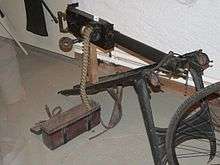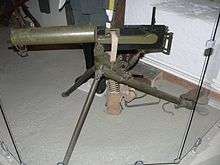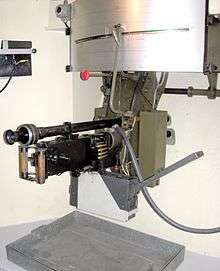MG 11
The Maschinengewehr Modell 1911 or MG 11 is a Swiss heavy machine gun which was introduced before and during World War I. The MG 11 has a narrow constructive relationship with the German MG 08 heavy machine gun.
| Maschinengewehr Modell 1911 (MG 11) | |
|---|---|
MG 11 (revisions 1934/1935 variant) mounted on its tripod | |
| Type | Heavy machine gun |
| Place of origin | Switzerland |
| Service history | |
| In service | 1911-1980s |
| Used by | Swiss Army |
| Production history | |
| Designer | Hiram Maxim / Waffenfabrik Bern |
| Designed | 1911 |
| Manufacturer | Waffenfabrik Bern |
| Produced | 1911 - 1946 |
| No. built | 10,000+ |
| Variants | MG 11 revisions 1934/1935 |
| Specifications | |
| Mass | 18.7 kg (41.23 lb) (without tripod) |
| Length | 1,100 mm (43.3 in) |
| Barrel length | 721 mm (28.4 in) |
| Cartridge | 7.5x55mm Swiss GP 11 |
| Caliber | 7.5 mm |
| Action | Short recoil, Toggle locked |
| Rate of fire | 500 rounds per minute |
| Muzzle velocity | 750 m/s (2,460 ft/s) |
| Feed system | canvas and metal links belt |
| Sights | Iron sights optical sight |
History
The MG 11 was based on the water-cooled Maxim machine gun, which had been developed by Hiram Stevens Maxim in 1885. The MG 11 was the last of a series of Swiss derivatives of the Maxim machine gun.
7.5 mm Maschinengewehr Modells
1894 (MG 94)

Between 1891 and 1894 Switzerland procured 72 heavy machine guns, designated MG 94, from Maxim and Nordenfelt in London and Deutsche Waffen und Munitionsfabriken (DWM) Berlin. These weapons were issued to fortress troops and mountain troops and were operational until 1944 as spare arms with the Territorial Battalion. The MG 94 was mounted at the front end and at the rear on the knees of the gunner. Two leather padded rings on the left and on the right sides of the breech of the weapon rested on the knees of the machine gunner sitting behind it and permitted sweeping fire. The machine gun MG 94 was chambered for the 7.5x53.5 mm GP 90 cartridge and was later, along other minor technical modifications, adapted for firing the more powerful 7.5x55 mm GP 11 cartridge. Six MG 94 had their water-cooling mantles drilled and cut open, making these guns air-cooled and thus water-free and lighter for use as aircraft machine guns. These 6 MG 94 air-cooled guns were taken out of service in 1944.
1900 (MG 00)

In 1899 Switzerland procured 69 heavy machine guns, designated MG 00, mainly from Vickers, Sons & Maxim in London. These guns had tripod mounts designed for cavalry use with a gunner's seat attached to the rear support strut. The machine gun MG 00 was chambered for the 7.5x53.5 mm GP 90 cartridge and was later adapted for firing the more powerful 7.5x55 mm GP 11 cartridge.
1911 (MG 11)

The MG 11 at first was originally procured from DWM Berlin. As German deliveries ceased during World War I, the manufacturing of the MG 11 was taken up in 1915 by the Eidgenössischen Waffenfabrik W+F (confederate weapon factory W+F) Bern.[1]
The MG 11 was a water-cooled heavy machine gun and mounted on a tripod. It was chambered for 7.5x55 mm GP 11 ammunition and came into service with the army, cavalry and was also used in fortresses, tanks and on airplanes of the Swiss Army. When applied in a fortress an optical sight and ball armoured screen was applied, the water cooling was connected to a tank and a sealing rubber was mounted behind the muzzle to prevent the penetration of flamethrower oil into the bunker.
1934/1935 modernization programme
In 1934 and 1935 the MG 11 machine guns were adapted for using then modern metal machine gun belts that started to replace the canvas belts used by the original Maxim machine guns. A flash suppressor at the muzzle was also introduced. Further a new trigger system was fitted that allowed one handed firing, so the gunner could simultaneously operate the sweeping fire control wheel at the tripod, and additional kit for anti aircraft usage. The modernized MG 11 machine guns were marked with a white stripe running along the length of the cooling sleeve.
Beginning in the early 1950s the MG 11 was gradually replaced by the air-cooled 7.5 mm Maschinengewehr Modell 1957 (MG 51) general-purpose machine gun. The replacement process was finished in the 1980s.
Variants
- MG 94 on knee-mount
- MG 00 on tripod, with simple sweep mounting
- MG 11 standard version during World War I
- MG 11 (revisions 1934/1935)
References
- Am Rhyn, Michael und Reinhart, Christian: Bewaffnung und Ausrüstung der Schweizer Armee seit 1817, Band 14, Automatwaffen II, Maschinengewehre, Sturmgewehre, Minenwerfer. Zürich 1983. S. 228
Sources
- Schweizerische Armee (Hrsg.): Technisches Reglement Nr. 3, Das schwere Maschinenge-wehr (Mg. 11), provisorische Ausgabe 1939, Bern 1939
- Bericht des Chefs des Generalstabes der Armee an den Oberbefehlshaber der Armee über den Aktivdienst 1939-45
- Robert G. Segel (14 October 2011) "The Swiss MG11 Maxim Machine Gun", Small Arms Defense Journal,·Vol. 2, No. 3
- Maschinengewehre und leichte Fliegerabwehr, Bulletin für die Mitglieder des Vereins Schweizer Armeemuseum, 2007/1
External links

